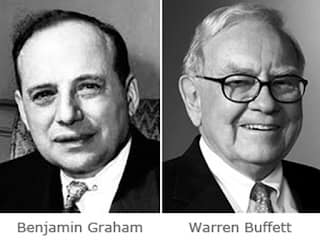
Value is what you get and price is what you pay. Indeed, undervalue stock investing strategy is as simple as shoppers buy familiar brands of products during sales (eg Great Singapore Sales in Jun-Aug, 11 Nov internet retailer sales, etc).
However, an investor may feel frightened when “discount” in stocks are incresing, eg. buying a stock with 50% price correction but it continues to fall, sometimes may not recover at all (bankrupt of company during crisis) or long period of low prices.
At the same time, a shopper seldom feel frightened when merchant B gives more discount than merchant A as a discount is already enjoyed, shopper knows that it is impossible to buy at the most discount.
This implies that there is a gap between stock investor and shopper, particularly related to mindset of value vs price. Let’s learn 3 main strategies in undervalue stock investing:
1) PB (Asset Method)
Price to Book (PB) ratio is share prices / Net asset value, a common way for smart investor to buy undervalue stocks with PB<1 or share price below net asset value for discount. This method requires high quality asset such as property or cash, not goodwill or licenses, etc.
The constraint of this method is an investor has limited selection of stocks (eg property or bank related stocks) and require patience to hold through the recovery phase.
Giant stock such as Hongkong Land (SGX: H78) is very undervalue with PB about 0.3 or 70% discount (price below valuation of net asset value). However, when investing during downtrend in share prices, there is more “discount” given, not limited to Hongkong Land, also commonly observed in many undervalue property stocks in Singapore and regional stock markets (eg Hong Kong, Malaysia, etc).
This method is more suitable for longer term investor (over 5-10 years) who ignore daily share prices. Benjamin Graham, father of value investing invented this method but it may not be suitable for everyone, especially short term Traders.
2) PE (Earning Method)
Price Earning (PE) ratio, share price over earning, is another common way for valuation, buying stocks with low PE.
The constraint of this method is limited to company with consistent growth. So, whenever there is a correction in share price during “crisis”, it would create a low PE opportunity.
However, this method may not be suitable for everyone as it requires good understanding of growth stocks with strong economic moat. Past historical low PE may not be a suitable reference (unlike PB<1 is a clearer criteria). Besides, each sector has its own average PE, eg higher for technology and healthcare sectors, lower for property sector. Therefore, it requires relative comparison of PE within similar sector among the peers.
Growth investing and value investing is just a fine line in between. Warren Buffett used to follow undervalue investing of his teacher, Benjamin Graham (asset method) in early years but found the choices of stocks are limited when share prices are much higher. His partner, Charlie Munger, encourages him to move towards growth investing, consider to buy an excellent business at fair price. This is aligned with teaching by second teacher of Warren Buffett, Philip Fisher, who view value as future growth, not limited to current asset.
Stock such as Apple Inc (Nasdaq: AAPL) has PE of about 22, considered “undervalue” within technology or internet sector. The stock may not be cheap in asset valuation, but it is undervalue based on future growth prospect.
3) Optimism (Ein55 Method)
Optimism is 1 of 55 Ein55 investing styles developed by Dr Tee. Optimism method is a unique way to integrate PE and PB methods, allow applications in all types of stocks, not limited to asset based or growth based. Optimism is ranging from 0-100%, a stock is undervalue when < 50% optimism, very undervalue when < 25% optimism, over price when > 75% optimism, fair value when near to 50% optimism.
For example, Hongkong Land is at 2% Optimism (very undervalue) while Apple is at 34% optimism (fair price). Optimism provide a quick and reliable way to integrate value and price together for investors to make decision. 50% optimism is an easy way of valuation for any stock.
However, Buy Low may get lower before one could Sell High. Therefore, it is crucial to integrate at least 5 Ein55 styles together with LOFTP Analysis:
L = Level Analysis (L1-L4)
O = Optimism Analysis (0-100%)
F = Fundamental Analysis (strong / weak)
T = Technical Analysis (Uptrend / Sideways / Downtrend)
P = Personal Analysis ( personality – short term trading or long term investing)
============
Warren Buffett is a famous counter-trend investor (although sometimes he also follow “business trend” to buy stock such as Apple), the more share price drops, the more he would buy stocks with cash. His pocket is deep (Berkshire is an insurance giant stock, the premium collected from insurance provide enormous cash reserve for Berkshire through Warren Buffett to invest for higher return during crisis). If one has limited capital with low risk appetite, trend-following could be a better choice, wait for confirmation before trading or investing.
Haw Par (SGX: H02) is a giant stock (which also invest in other giant stocks of Mr Wee), hidden jewel of Mr Wee Cho Yaw, UOB Chairman. We have covered this stock in details several years ago in Ein55 charity course (Discounted NAV stock) and also in Ein55 mentor course on Fundamental Analysis (either course #1 or #2), share price was less than $9 (undervalue) then, with over 50% capital gains in a few years later.
I have studied the cross-holding structure of Mr Wee network of stocks and Jardine Group in Ein55 coaching several years ago and also briefly in this article:
Cross-holding structure can strengthen the control but if not a simple majority control (over 50%), it could break down one by one as well when 1 of the stock is controlled by competitor. So, we could see Mr Wee Cho Yaw has been increasing ownership in his network of shares over the past few years to strengthen the control, not just leveraging on cross-holding structure.
It is never too late to master the right ways of stock investing and trading, aligned with own personality. Take action now to learn 10 stock strategies in Dr Tee 4hr stock investment course (free but requires commitment to learn).
Register Here: www.ein55.com

